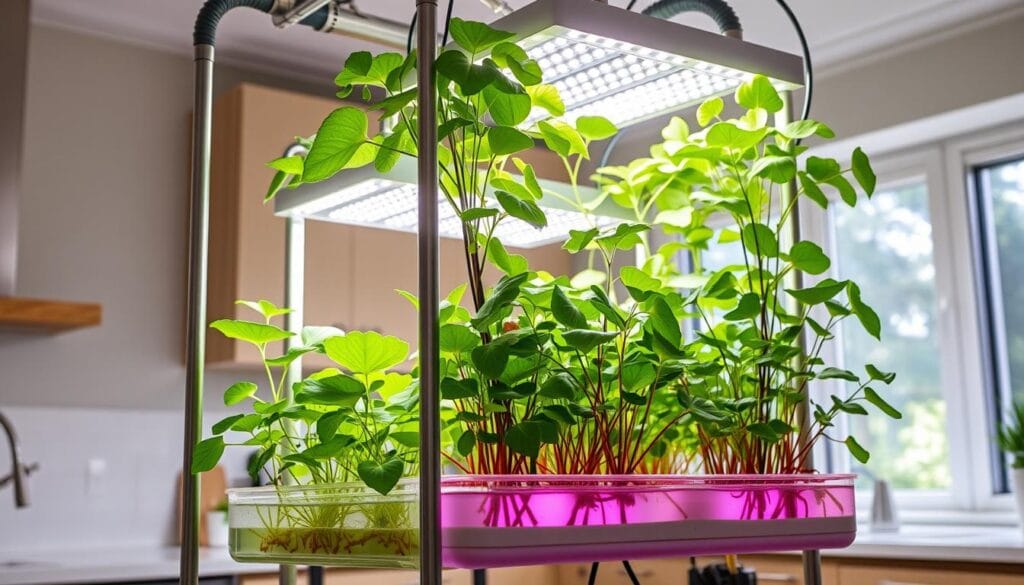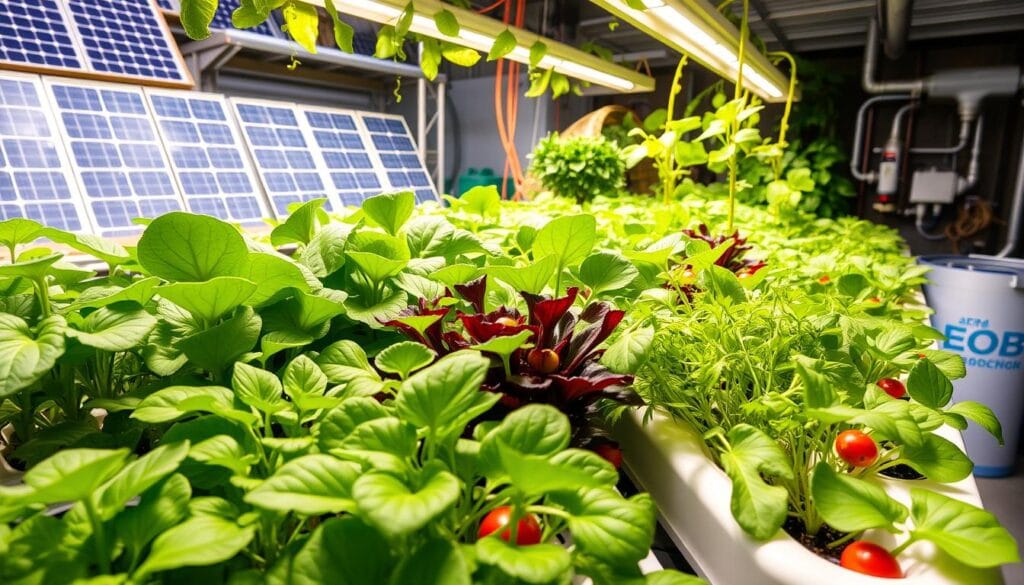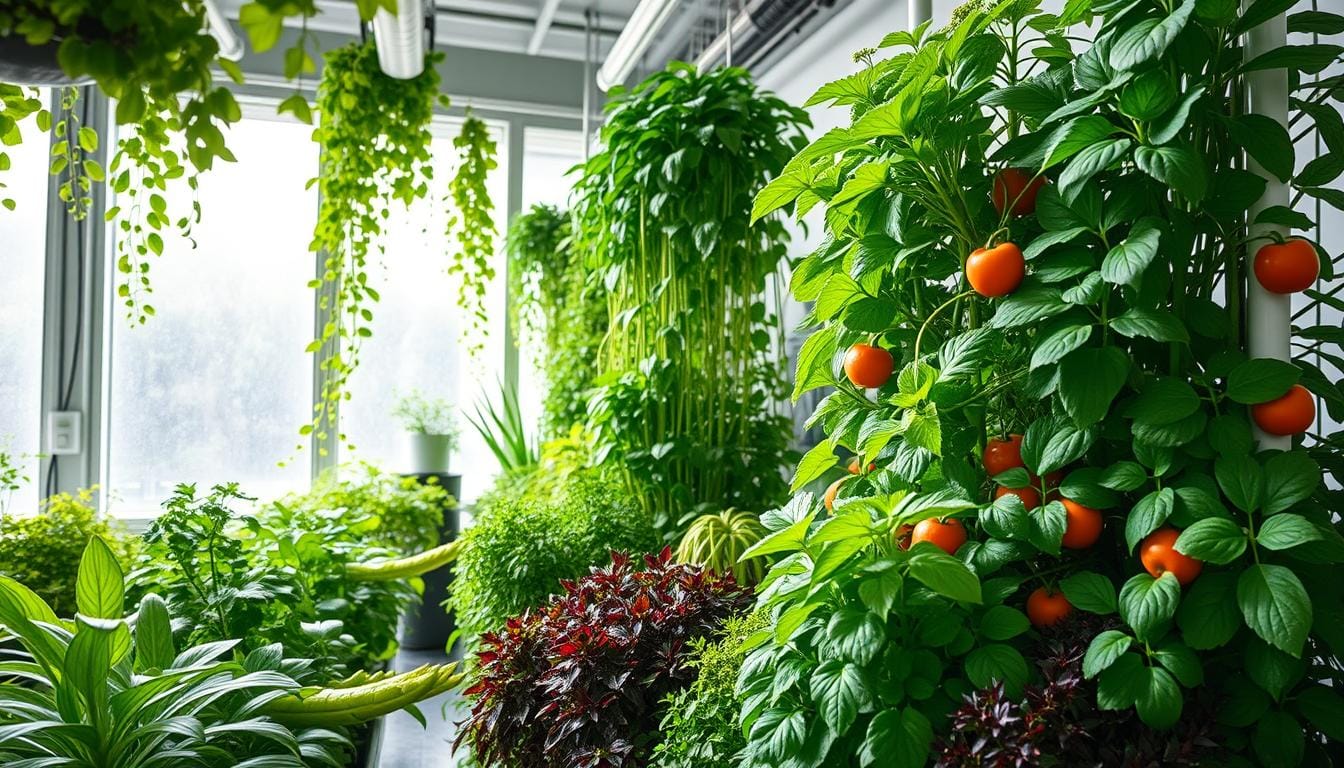Start Hydroponics Gardening as a revolutionary way to farm without soil. This method uses nutrient-rich water to foster plant growth, saving water, reducing space needs, and allowing for year-round food production. Starting a hydroponic garden in 2024 offers many benefits, making it an excellent choice for sustainable and efficient gardening.
Key Takeaways
- Hydroponic systems conserve water by using up to 90% less than traditional soil-based agriculture.
- Hydroponic plants can grow faster and produce higher yields due to direct access to nutrients.
- Vertical hydroponic setups maximize space efficiency, making them ideal for urban and indoor gardening.
- Hydroponic systems can be designed to minimize pests and diseases, reducing the need for pesticides.
- Hydroponics eliminates the need for soil, making it a viable option for areas with poor or contaminated soil.
Understanding Modern Hydroponic Systems
Hydroponic gardening offers an innovative method for cultivating plants without soil, using nutrient-rich water or mist to support plant growth. This setup gives plants the right mix of oxygen, nutrients, and water for growth.
Defining Soilless Cultivation
Soilless cultivation is key to hydroponics. Instead of soil, plants grow in mediums like perlite, vermiculite, or coco coir. These mediums support the roots and deliver nutrients directly to the plants.
Basic Components of Hydroponic Setup
- Water pumps to circulate the nutrient solution
- Growing trays or containers to hold the plants and growing medium
- Lighting systems to provide the appropriate wavelengths and intensity of light
- Nutrient solution reservoirs to supply the essential nutrients
Popular Growing Methods
- Nutrient Film Technique (NFT): A continuous flow of nutrient-rich water is circulated through a shallow channel, allowing the plant roots to absorb the nutrients.
- Ebb and Flow: Also known as Flood and Drain, this method involves periodically flooding the grow tray with nutrient solution and then draining it, simulating the natural ebb and flow of a tide.
- Drip Systems: Nutrient solution is slowly dripped onto the growing medium, providing a steady supply of moisture and nutrients to the plants.
- Aeroponics: Plants are suspended in the air, with their roots exposed to a fine mist of nutrient-rich water, allowing for efficient nutrient uptake.
These systems are very flexible, allowing for many types of crops. They use space well and grow plants fast. Hydroponics also keeps pests and diseases away, making it great for growing all year.
| Hydroponic System | Water Usage Reduction | Growth Rate Increase | Pest and Disease Reduction |
|---|---|---|---|
| Nutrient Film Technique (NFT) | 90% | 25-30% | Significant |
| Ebb and Flow | 80% | 20-25% | Considerable |
| Drip Systems | 70% | 15-20% | Moderate |
| Aeroponics | 95% | 30-35% | Highly Effective |
Hydroponic systems are a green and efficient way to garden. They’re becoming more popular for both big farms and home gardens. By learning about these systems, you can grow more food all year long.
The Environmental Impact of Hydroponics
Hydroponics is a key to a greener future in farming. It uses less water, cuts down on pesticides, and makes farming in cities possible. This method is a big step towards a more eco-friendly way of growing food.
Hydroponic farming needs 98% less water than traditional farming. This method is especially beneficial in regions facing water scarcity. For example, a hydroponic farm in California helped feed a school’s salad bar for a week. It did this without using much water or land.
Hydroponics also means less pesticide use. Because hydroponics is controlled, there’s less chance of pests and weeds. This is good for the environment and makes the food healthier and more nutritious.
Hydroponics lets us grow food in cities, which cuts down on transportation emissions. In Wisconsin, high school students run a hydroponic farm. They learn valuable skills and grow food for local businesses and communities.
However, hydroponics might use more energy because of artificial lighting and climate control. But, using solar power can help reduce this energy use.
Hydroponics is a big help in solving global problems like water scarcity and food security. By using hydroponics, we can create a future where farming is more sustainable, uses fewer pesticides, and is more energy-efficient.
Water Conservation Benefits in Hydroponic Growing
Hydroponic farming systems save a lot of water compared to traditional farming. It can reduce water usage by as much as 90%. This is great for places with little water or where it often rains too little.
The secret to saving water is how hydroponics recycle and control water. They make sure every drop is used well.
Comparing Traditional vs Hydroponic Water Usage
Traditional farming loses a lot of water. It goes to evaporation, runoff, and bad irrigation. But hydroponics are different.
They use a closed-loop system. This means water can be reused over and over. This cuts down on waste and saves a lot of water.
Recycling Water in Closed Systems
Systems like deep water culture and nutrient film technique are very water-efficient. They keep the water moving in a loop. This approach minimizes waste and conserves water.
They also control how much water each plant gets. This makes sure no water is wasted.
Drought Resistance Advantages
Hydroponics are perfect for places with little water. They require up to 90% less water compared to conventional farming methods. This means growers can still succeed even when water is scarce.
Tools like the Growee Pro Combo help even more. They automate water levels, pH, and nutrients. This helps maintain plant health while conserving water.
Space-Efficient Urban Farming Solutions
In cities, where space is limited, vertical farming techniques and compact growing systems are changing how we farm. Hydroponics, for example, can be set up in many places. This includes apartments, libraries, restaurants, and schools, bringing fresh food right to the city’s heart.
The Flex Farm is a great example. It’s a vertical hydroponic system that can grow up to 25+ lbs of food every 28 days. It can grow over 3,400 plants a year in a small space. This shows how hydroponics can save space and help feed cities.
Also, hydroponics can cut labor costs by about 30% compared to old farming ways. Eden Green Technology is a leader in this field. Their greenhouses use 90% less light, 99% less land, and 98% less water than traditional farms. They also keep food safe, ranking in the top 1% of all safe food environments.
| Metric | Traditional Farming | Vertical Farming |
|---|---|---|
| Water Usage | High | Up to 98% less |
| Land Usage | Extensive | 99% less |
| Light Energy | High | 90% less |
| Food Safety | Varies | Top 1% of all food-safe environments |
| Harvest Cycle | Seasonal | 28 days on average |
| Annual Harvest | Limited | 2,500 tons of leafy greens |
By using vertical farming techniques and compact growing systems, urban farmers can make a big difference. They can turn unused spaces into places where fresh, healthy food grows. This new way of farming could change how we produce and share food in cities. It could lead to a more sustainable and fair future.
Year-Round Growing Capabilities
Discover the power of indoor gardening and controlled environment agriculture with hydroponic systems. These systems allow for year-round production. They break free from seasonal weather limits, letting growers cultivate a wide variety of crops. This ensures a constant flow of fresh produce all year long.
Climate Control Advantages
Hydroponic setups offer precise control over temperature, humidity, and light. This creates the perfect environment for plants to grow. Plants in hydroponic systems can grow up to 5 times faster than those in soil.
Seasonal Independence
Outdoor farming is limited by changing seasons and unpredictable weather. Hydroponic systems, however, provide a year-round growing solution. This lets farmers supply fresh produce consistently, no matter the season.
Maximizing Growth Cycles
Hydroponic systems control the growing environment precisely. This optimizes plant growth cycles, leading to higher yields than traditional farming. This approach is more sustainable and productive, tackling food security and environmental challenges.
Hydroponic systems are the future of agriculture. They enable year-round growing, climate control, and seasonal independence. They pave the way for a more sustainable and abundant food future.
| Hydroponic Growing Advantages | Traditional Soil-Based Farming |
|---|---|
| Year-round production | Seasonal limitations |
| Precise climate control | Dependent on outdoor conditions |
| Faster growth (up to 5x) | Slower growth rates |
| Higher annual yields | Lower overall productivity |
| Water-efficient systems | Higher water consumption |
Start Hydroponics Gardening: Essential Steps
Starting your hydroponic gardening journey is exciting. It’s great for beginners or those wanting to grow more indoors. Knowing the key steps is crucial for success. This guide will help you set up a thriving beginner hydroponics system.
Choosing the right hydroponic setup is your first step. You can pick from the Wick System, Water Culture, Ebb and Flow, or Nutrient Film Technique (NFT). Each has its own benefits, so it’s important to pick the best for your plants.
After picking your system, you’ll need to set it up. This includes a water reservoir, grow trays, pumps, and growing media like rockwool or coconut fiber. Good lighting, whether from the sun or artificial, is also key for plant health.
- Determine the right hydroponic system for your needs
- Gather the necessary equipment and supplies
- Prepare the growing media and nutrient solution
- Establish a suitable environment for your plants
- Monitor and maintain your hydroponic setup regularly
Hydroponic gardening needs some money upfront and regular care. But the rewards are worth it. With the right effort, you can grow fresh, tasty produce at home or in the city.

“Hydroponics is the future of gardening, allowing us to grow more with less.”
Starting small with easy crops like lettuce or herbs is a good idea. It helps you get better at hydroponic gardening. With patience and a willingness to learn, you’ll soon have a thriving DIY hydroponic system.
Maximizing Crop Yields Through Nutrient Control
In hydroponic gardening, controlling nutrients is crucial for plant growth and harvests. Hydroponic systems let growers adjust nutrient solutions for each plant. This ensures they get the right mix of nutrients for growth.
Understanding Nutrient Solutions
Nutrient solutions have macronutrients like nitrogen, phosphorus, and potassium. They also have micronutrients like iron, calcium, and magnesium. Growers adjust these nutrients for the best plant growth and crop yield optimization.
pH Management Techniques
Keeping the pH balanced is key in hydroponics. Plants grow best in a pH of 5.5 to 6.5. Growers use meters and kits to check pH and adjust it with special solutions.
Growth Optimization Strategies
- Adjusting light exposure to meet the specific needs of each plant species
- Maintaining ideal temperature and humidity levels to support healthy growth
- Fine-tuning nutrient concentrations based on the plant’s growth stage and specific requirements
By carefully managing nutrient solutions, pH balancing, and other factors, growers can maximize their crops. This leads to amazing crop yield optimization and consistent harvests.
“Proper nutrient management is the foundation for thriving hydroponic gardens and unparalleled crop yields.”
Cost Analysis and Return on Investment
When looking at hydroponic economics, the initial startup costs are key. But, the long-term gains often make up for the initial spend. The type of hydroponic system, operation size, and energy needs for lighting and climate control affect costs.
Even with higher start-up costs, hydroponics can bring in big returns. This is due to higher yields and constant production. Plus, using less water, fewer pesticides, and selling fresh, local produce can lower costs.
To see if hydroponics is worth it, do a detailed cost analysis. Think about the long-term benefits. This helps decide if hydroponic gardening fits your business or personal growing needs.
| Metric | Traditional Farming | Hydroponic Farming |
|---|---|---|
| Water Usage | High | Low (up to 90% less) |
| Yield per Square Foot | Low | High (up to 16 times greater) |
| Pest and Weed Control | Extensive Use of Pesticides | Minimal to No Pesticides Required |
| Nutrient Efficiency | Moderate | High |
| Environmental Impact | High (Fertilizer Runoff, Soil Depletion) | Low (Closed-Loop System, Reduced Waste) |
Compare startup costs and operational expenses with the potential hydroponic economics and returns on investment. This helps decide if hydroponic gardening is right for you.

Disease Prevention and Pest Management
Hydroponic systems face fewer pest and disease problems than traditional farming. This is because they are in a controlled environment. This environment shields them from soil-borne pathogens and many pests. Yet, issues like root rot, nutrient deficiencies, and certain insects can still happen.
Common Plant Health Issues
Pests like aphids, spider mites, and whiteflies can affect hydroponic crops. Diseases such as Pythium, a water mold, and fungal infections can also occur. Keeping water quality high, ensuring good air circulation, and keeping the system clean are key to preventing these problems.
Prevention Strategies
To keep hydroponic plants healthy, use Integrated Pest Management (IPM) techniques. Also, use beneficial insects like ladybugs and predatory mites. Good cultural controls, like crop rotation and keeping things clean, are also important.
Regular checks, catching problems early, and acting fast are vital. This way, you can handle any pest or disease issues before they get worse.

